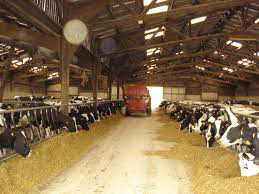Concept Of Total Mixed Ration
Author :Dr Jacob Gusha (Ph.D)
Introduction
Feeding dairy cows in Zimbabwe is a serious challenge given that there are eight months of the dry season and four months of the rainy season. These seasons bring about great fluctuation in the quality and quantity of available fodder for dairy cows. Farmers inevitably resort to crop residues and poor quality hay as the main sources of nutrients for their dairy cows. One should adopt a nutritional management system that allows for accurate and efficient nutritional analysis of locally available ingredients, recipes, and cafeteria menus, as well as the cow’s nutrient demand and intake. This is critical in making sure that the feed provided through the blending of available ingredients produces a nutritious and digestible feed to meet the desired nutrients of a dairy cow. There are three well known nutritional management systems. These are Total Mixed Ration (TMR) fed to dairy cows in confinement, concentrate and forage fed without being blended to dairy cows in confinement and a pasture-based system where cows graze in improved pastures. Total Mixed Ration (TMR) is an efficient and effective feeding system that delivers all nutrients to dairy cattle. Zimbabwe has abundant natural hay in rangelands and cereal straw during the dry season.
Feeding and nutritional management systems for dairy cows
There are three general types of nutritional management systems that are used in dairy production namely; Confinement systems with Totally Mixed Rations (TMRs), Confinement systems in which concentrates and forages are fed separately, and Pasture-based systems. In Zimbabwe, farmers tend to use all of them but with limited understanding of how to efficiently benefit from each of the systems. In experiments conducted in Watsomba and Chikomba districts of Zimbabwe, TMR is the most effective method even with very low quantities of concentrate feedstuffs. The other systems are elaborated here for producers to decide which method to use at their farms
Total Mixed Rations (TMR)
A TMR is a method of feeding cows that combines feeds formulated to a specific nutrient- content into a single feed mix. Proper nutrition leads to healthy and high-performing dairy cows. The cow’s ration should have good quality forages, a balance of grains and protein sources, vitamins, and minerals. These feed sources provide nutrients needed for milk production, growth, and reproduction. One must balance the nutrients in a ration to avoid excesses or deficiencies.
Balancing rations to meet the cows’ nutrient needs can optimise feed digestion and use. This minimises fluctuations in rumen pH and promotes healthy rumen conditions, even at relatively high rates of energy intake
In conventional TMR, chopped green fodder or silage are blended with cereals, cereal by-products, protein sources, minerals, vitamins and feed additives to provide a balanced ration to the dairy animals. In Zimbabwe, during the dry season we used a Dry TMR which was made up of chopped maize stover, grass hay blended with a dairy meal, custom beef fattening meal cereals, cereal by-products, protein sources (such as Mabiko K and urea), minerals, vitamins, and feed additives to provide balanced ration to the dairy animals. The dry TMR has the following advantages:
It enables better feed intake, reduces feed wastage, maintains a stable rumen environment, and improves microbial protein production and digestibility; It can be customised to the lactation stage of the animals and therefore contributes to higher productivity; The roughage portion of this TMR primarily comprises crop residues such as maize stover, wheat straw, grass hay, poultry litter, spent/brewer’s grain, citrus pulp, etc., which are available in abundance locally; Incorporation of these crop residues prevents them being burnt in the fields, thus mitigating the adverse effect on the environment and The TMR thus produced is economical than the conventional cattle feed of similar nutrient composition.

For effective use of TMR diets, cows must be separated into early, mid, and late lactation stages and dry cows. One dry cow group should comprise those cows in the first four- six weeks of the dry period, and the other those in the two- four weeks before calving. Diets for lactating cow groups should be balanced for more milk production. This is to ensure that the nutrient requirements of the higher-producing cows in the group are met. Optimal balance for the nutrient requirements depending on the number of feeding groups and their stage of lactation should be guaranteed.
Confinement systems in which concentrates and forages are fed separately.
Most farmers have underperforming dairy cows because of wrong and inappropriate feeding methods. It is not necessarily true that Zimbabwe dairy farmers have a shortage of feed resources to feed their dairy animals. It is the absence of technical know-how on how to feed a dairy cow as well as the fact that available resources are fed separately. Unmixed or component feeding method do not allow proper performance of dairy cows. Starches and concentrates are fed separately while poor roughages are fed on their own with either salt or molasses. Starch, concentrates and other non-fibre carbohydrates are provided in very minute quantities per day, especially during milking time. The major disadvantage when starch is offered without relish is that there is a greater possibility for large fluctuations in rumen pH, which may impair the degradation and digestion of hay and crop residue and contribute to poor rumen health. To most farmers, this system was designed to avoid the use of large quantities of concentrated meals. When a component or unblended feeding system is used there is a greater possibility for underfeeding because of the inability to monitor forage intake. This is because chances are high that the amount of forage offered is not weighed if it is not being mixed with other diet components. Thus, there is no means to accurately adjust concentrate intake to match fluctuations in forage consumption. This becomes a particular problem in hot weather during which forage consumption may be reduced substantially while concentrate consumption is less affected. This leads to alterations in the intended proportions of fibre and non-fibre carbohydrates in the diets.
Pasture-based systems.
Pasture management has evolved to optimise the use of forage resources in pasture- based feeding systems. Such systems require intensive pasture management of pasture for optimal dry-matter and nutrient yields and for optimal feeding and nutrition of high-producing dairy cows. To achieve these goals, paddocks must be rotated frequently, so forages are consumed at an optimal stage of growth and overgrazing should be avoided. Pastures are typically divided into paddocks. Dairy cows are rotated through paddocks as forages reach stages of growth which is optimal for both dry-matter yields and nutrient composition. From a nutritional point of view, the three major challenges of pasture-based dairy systems are namely; maintaining favourable rumen fermentation conditions, maintaining adequate dry matter intake, and meeting energy and protein requirements. Creating and maintaining a stable and healthy rumen ecosystem and ensuring that the cow is taking adequate dietary fibre are the biggest challenges with pasture-based systems. Young and fast growing pasture grasses have high energy and protein density but are deficient in Neutral Detergent Fibre (NDF) concentrations. Hence there is quick rumen fermentation resulting in low pH production and unstable rumen environment. Supplementing the pasture with dry forages to maintain adequate effective fibre concentrations is frequently necessary in all pasture-based feeding systems. Dry matter consumption in pasture systems may limit nutrient intake because maximal consumption rates are lower than in confinement systems. This will limit energy intake, thus requiring supplemental energy sources to be fed to achieve high milk production. Milk production rates in unsupplemented pasture feeding situations are seldom >25 kg/day. Energy supplements may include starches such as cereal grains or highly fermentable fibre sources such as grain by-products. Protein, and particularly sources of Rumen-undegradable protein (RUP), may also need to be supplemented. Protein concentrations in pasture grasses may be high but are generally highly rumen degradable.
For more information contact
Dr Jacob Gusha (Ph.D)
ZADF Feed Consualtancy
University of Zimbabwe
Faculty of Veterinary Science
Department of Animal Production & Veterinary Medicine
P. Box MP167
Mount Pleasant
Harare
Mobile: +263 772 252514 or +26371251401
Email jtgusha@gmail.com
UNIVERSITY OF ZIMBABWE

DEPARTMENT OF ANIMAL PRODUCTION AND VETERINARY MEDICINE
IN COLLABORATION WITH
ZIMBABWE ASSOCIATION OF DAIRY FARMERS

